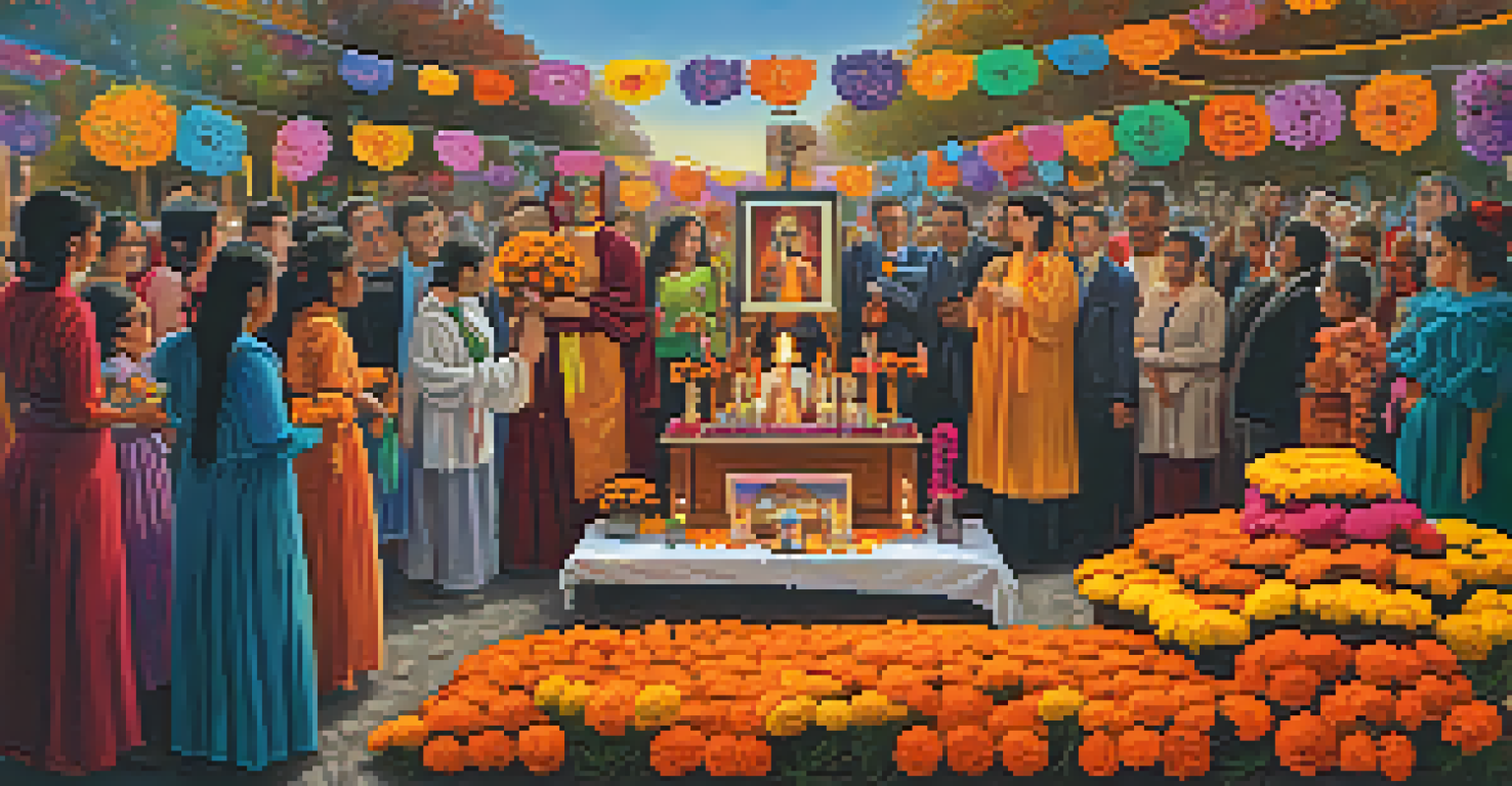Legends of La Llorona: The Weeping Woman of Spanish Lore

The Origins of La Llorona in Spanish Folklore
La Llorona, or 'The Weeping Woman,' is rooted in Spanish folklore, often told to instill caution in children. The story varies by region, but it typically revolves around a mother who, in her grief, mourns her lost children. This tale serves as both a cultural warning and a symbol of maternal love gone tragically wrong.
The greatest tragedies are the ones we create for ourselves.
While many versions exist, the most common narrative depicts a woman named Maria who drowns her children in a fit of rage or despair, only to regret her actions deeply. As a result, she wanders the rivers and lakes, endlessly searching for them, her cries echoing in the night. This haunting image captures the essence of loss and the consequences of one's actions.
The legend's appeal lies in its ability to evoke empathy and fear, making it a powerful cautionary tale passed down through generations. La Llorona not only reflects the pain of motherhood but also serves as a reminder to heed warnings and respect the boundaries of love and anger.
Cultural Significance and Variations of the Legend
La Llorona's legend is not confined to one culture; it has permeated various Latin American countries, each adding its unique spin. In Mexico, she is often depicted as a beautiful woman who transforms into a ghostly figure, while in other regions, she may represent broader themes of loss and regret. This adaptability highlights the story's relevance across different cultures and generations.

In some variations, La Llorona is portrayed as a protector of children, warning them against dangers near water. This duality makes her both a figure of fear and a maternal guardian, illustrating the complexities of motherhood. Such contradictions add depth to her character, making her a relatable figure for many.
La Llorona's Cultural Roots
The legend of La Llorona reflects deep cultural themes of loss, love, and the consequences of one's actions, varying across different Latin American traditions.
As the legend continues to evolve, it remains a staple in storytelling, often recounted around campfires or during family gatherings. This enduring nature speaks to its significance in cultural identity and the shared experiences of loss and redemption among communities.
The Impact of La Llorona on Modern Media
La Llorona's haunting tale has found its way into modern media, influencing films, books, and art. Notably, the 2019 film 'The Curse of La Llorona' brought the legend to a broader audience, showcasing its chilling narrative in a contemporary horror format. Such adaptations allow new generations to engage with the lore and explore its themes of grief and consequence.
Grief is like the ocean; it comes in waves, ebbing and flowing. Sometimes the water is calm, and sometimes it is overwhelming.
Beyond horror films, La Llorona has inspired numerous literary works that delve into her story, often reinterpreting it through different lenses. These narratives explore themes of identity, loss, and redemption, emphasizing the timeless nature of her tale. Each retelling adds layers to her character, ensuring her legacy endures.
Moreover, La Llorona has become a symbol of cultural pride and resilience among Latinx communities. Through art, music, and storytelling, she embodies the struggles and strengths of motherhood, making her a powerful figure in both folklore and contemporary discussions.
Lessons and Morals Embedded in La Llorona's Story
At its core, the legend of La Llorona teaches valuable lessons about the consequences of one's actions. Her sorrowful cries serve as a reminder to cherish loved ones and the importance of making wise choices. This moral undertone resonates deeply, particularly within family-oriented cultures where the story is often shared.
The narrative also highlights the dangers of unchecked emotions, illustrating how anger and despair can lead to irreversible consequences. By examining Maria's tragic decisions, listeners are encouraged to reflect on their own emotional responses, prompting discussions around mental health and emotional well-being.
Modern Interpretations in Media
La Llorona has influenced contemporary media, inspiring films and literature that explore her story, making her a symbol of resilience and cultural pride.
Ultimately, La Llorona's story serves as both a cautionary tale and a source of empowerment. It encourages individuals to confront their emotions and seek help when needed, reminding us that vulnerability is part of the human experience.
La Llorona's Connection to Water and Nature
Water plays a significant role in the legend of La Llorona, symbolizing both life and death. The rivers and lakes where she is said to wander reflect the duality of nurturing and destructive forces. This connection to nature emphasizes the importance of respecting the environment and understanding its power.
In many cultures, water is viewed as a cleansing force, often associated with emotions and spirituality. La Llorona's weeping at the water's edge can be seen as a metaphor for the need to express grief and seek healing. This interpretation encourages individuals to connect with their emotions and find solace in nature.
Furthermore, the environmental implications of La Llorona's story remind us of the delicate balance between humanity and the natural world. As we navigate our lives, it's essential to respect and honor the elements that shape our existence, paralleling the respect we owe to our relationships.
Regional Celebrations and Commemorations of La Llorona
In regions where La Llorona is well-known, various celebrations and commemorations take place, particularly around Día de los Muertos (Day of the Dead). These events honor the memory of loved ones lost, allowing communities to come together and reflect on themes of life, death, and the afterlife. La Llorona's presence during these celebrations serves as a poignant reminder of the ties that bind us to our ancestors.
Festivals often include storytelling sessions where elders recount the legend, fostering a sense of community and shared heritage. These gatherings create a space for dialogue about loss and remembrance, making La Llorona a vital part of cultural identity. Through these stories, the next generation learns to appreciate their roots and the lessons embedded in them.
Lessons on Emotions and Healing
At its core, La Llorona's tale teaches important lessons about the impact of unchecked emotions and the necessity of cherishing loved ones.
Moreover, artistic expressions such as dance, music, and visual art often portray La Llorona, allowing her legend to live on in creative forms. These celebrations not only keep the story alive but also inspire new interpretations, ensuring that La Llorona remains a relevant figure in contemporary culture.
Why La Llorona Remains Relevant Today
La Llorona's legend continues to resonate today, serving as a powerful symbol of the struggles faced by mothers and families. In an age where mental health awareness is growing, her story prompts important conversations about grief, loss, and the impact of emotional turmoil. By examining her tale, we can better understand the complexities of human emotions and relationships.
Additionally, La Llorona embodies the challenges many face in seeking forgiveness and healing. Her endless search for her children mirrors the journey many undertake in confronting their past mistakes and seeking redemption. This connection makes her story relatable, transcending cultural boundaries and speaking to universal themes of love and loss.

Ultimately, La Llorona remains a relevant figure because her story is a reflection of our shared human experience. As we navigate the complexities of life, her tale reminds us to embrace our emotions, learn from our past, and cherish the connections we hold dear.